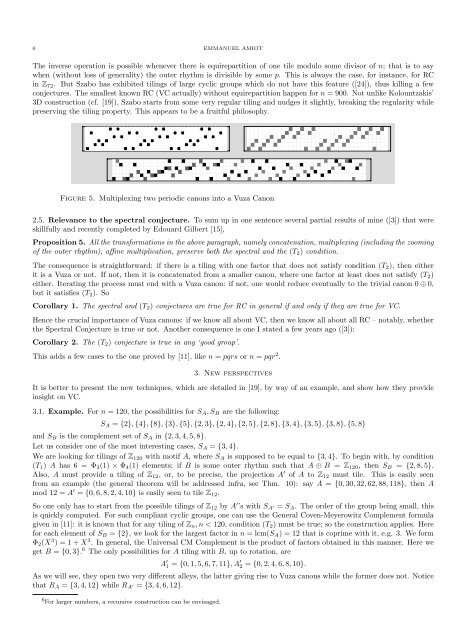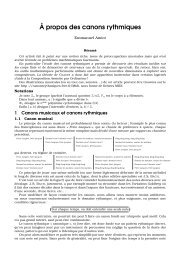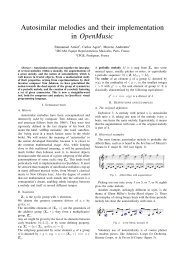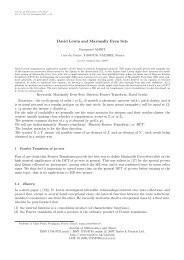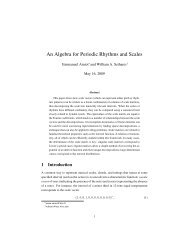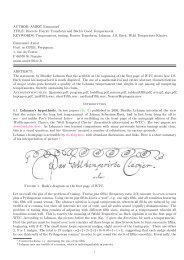Emmanuel Amiot Modèles algébriques et algorithmes pour la ...
Emmanuel Amiot Modèles algébriques et algorithmes pour la ...
Emmanuel Amiot Modèles algébriques et algorithmes pour la ...
You also want an ePaper? Increase the reach of your titles
YUMPU automatically turns print PDFs into web optimized ePapers that Google loves.
6 EMMANUEL AMIOT<br />
The inverse operation is possible whenever there is equirepartition of one tile modulo some divisor of n; that is to say<br />
when (without loss of generality) the outer rhythm is divisible by some p. This is always the case, for instance, for RC<br />
in Z72. But Szabo has exhibited tilings of <strong>la</strong>rge cyclic groups which do not have this feature ([24]), thus killing a few<br />
conjectures. The smallest known RC (VC actually) without equirepartition happen for n = 900. Not unlike Kolountzakis’<br />
3D construction (cf. [19]), Szabo starts from some very regu<strong>la</strong>r tiling and nudges it slightly, breaking the regu<strong>la</strong>rity while<br />
preserving the tiling property. This appears to be a fruitful philosophy.<br />
Figure 5. Multiplexing two periodic canons into a Vuza Canon<br />
2.5. Relevance to the spectral conjecture. To sum up in one sentence several partial results of mine ([3]) that were<br />
skillfully and recently compl<strong>et</strong>ed by Edouard Gilbert [15],<br />
Proposition 5. All the transformations in the above paragraph, namely concatenation, multiplexing (including the zooming<br />
of the outer rhythm), affine multiplication, preserve both the spectral and the (T2) condition.<br />
The consequence is straightforward: if there is a tiling with one factor that does not satisfy condition (T2), then either<br />
it is a Vuza or not. If not, then it is concatenated from a smaller canon, where one factor at least does not satisfy (T2)<br />
either. Iterating the process must end with a Vuza canon: if not, one would reduce eventually to the trivial canon 0 ⊕ 0,<br />
but it satisfies (T2). So<br />
Corol<strong>la</strong>ry 1. The spectral and (T2) conjectures are true for RC in general if and only if they are true for VC.<br />
Hence the crucial importance of Vuza canons: if we know all about VC, then we know all about all RC – notably, wh<strong>et</strong>her<br />
the Spectral Conjecture is true or not. Another consequence is one I stated a few years ago ([3]):<br />
Corol<strong>la</strong>ry 2. The (T2) conjecture is true in any ‘good group’.<br />
This adds a few cases to the one proved by [11], like n = pqrs or n = pqr 2 .<br />
3. New perspectives<br />
It is b<strong>et</strong>ter to present the new techniques, which are d<strong>et</strong>ailed in [19], by way of an example, and show how they provide<br />
insight on VC.<br />
3.1. Example. For n = 120, the possibilities for SA, SB are the following:<br />
SA = {2}, {4}, {8}, {3}, {5}, {2, 3}, {2, 4}, {2, 5}, {2, 8}, {3, 4}, {3, 5}, {3, 8}, {5, 8}<br />
and SB is the complement s<strong>et</strong> of SA in {2, 3, 4, 5, 8}.<br />
L<strong>et</strong> us consider one of the most interesting cases, SA = {3, 4}.<br />
We are looking for tilings of Z120 with motif A, where SA is supposed to be equal to {3, 4}. To begin with, by condition<br />
(T1) A has 6 = Φ3(1) × Φ4(1) elements; if B is some outer rhythm such that A ⊕ B = Z120, then SB = {2, 8, 5}.<br />
Also, A must provide a tiling of Z12, or, to be precise, the projection A ′ of A to Z12 must tile. This is easily seen<br />
from an example (the general theorem will be addressed infra, see Thm. 10): say A = {0, 30, 32, 62, 88, 118}, then A<br />
mod 12 = A ′ = {0, 6, 8, 2, 4, 10} is easily seen to tile Z12.<br />
So one only has to start from the possible tilings of Z12 by A ′ ’s with SA ′ = SA. The order of the group being small, this<br />
is quickly computed. For such compliant cyclic groups, one can use the General Coven-Meyerowitz Complement formu<strong>la</strong><br />
given in [11]: it is known that for any tiling of Zn, n < 120, condition (T2) must be true; so the construction applies. Here<br />
for each element of SB = {2}, we look for the <strong>la</strong>rgest factor in n = lcm(SA) = 12 that is coprime with it, e.g. 3. We form<br />
Φ2(X 3 ) = 1 + X 3 . In general, the Universal CM Complement is the product of factors obtained in this manner. Here we<br />
g<strong>et</strong> B = {0, 3}. 6 The only possibilities for A tiling with B, up to rotation, are<br />
A ′ 1 = {0, 1, 5, 6, 7, 11}, A ′ 2 = {0, 2, 4, 6, 8, 10}.<br />
As we will see, they open two very different alleys, the <strong>la</strong>tter giving rise to Vuza canons while the former does not. Notice<br />
that RA = {3, 4, 12} while RA ′ = {3, 4, 6, 12}.<br />
6 For <strong>la</strong>rger numbers, a recursive construction can be envisaged.


